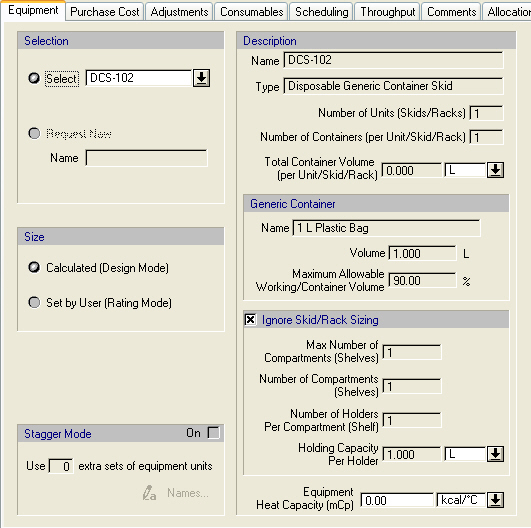

The following table shows the meaning of the variables appearing in this tab, as well as their default values and their generally acceptable range. Note that due to the manner by which the variables are used by the sizing and costing equations, the range of acceptable values may be further reduced.
|
Variable |
Default Value |
Range |
|
|
||
|
◙ Number of Containers (per Unit or Skid/Rack) |
1 |
Positive Integer |
|
● Total Container Volume (per Unit or Skid/Rack) |
0.0 L |
Positive |
|
● Name (of Container) |
1 L Plastic Bag |
|
|
● Volume (of Container) |
1.0 L |
Positive |
|
○ Maximum Allowable Working/Container Volume (of Container) |
90% |
(0,100] |
|
○ Ignore Skid/Rack Sizing |
<Yes> |
Yes/No |
|
◙ Max Number of Compartments (Shelves) |
1 |
Positive Integer |
|
◙ Number of Compartments (Shelves) |
1 |
Positive Integer |
|
◙ Number of Holders per Compartment (Shelf) |
1 |
Positive Integer |
|
◙ Holding Capacity Per Holder |
100.0 L |
Positive |
|
○ Equipment Heat Capacity |
0 kcal/°C |
Positive. |
Symbol Key: ○ User-specified value (always input); ● Calculated value (always output); ◙ Sometimes input, sometimes output
A Disposable Generic Container Skid requires use of a ‘Generic Container’ consumable. The default consumable used for this equipment is a ‘1 L Plastic Bag’. For information on how to select the required consumable and any additional consumables, see Disposable Generic Container Skid: Consumables Tab.
Sizing for this equipment can be done at two levels:
a) Number of Containers required
b) Number of Skids/Racks Required
In both Design and Rating mode, the user must select a consumable (a member of the ‘Generic Container’ type) to be used by this equipment. In Design mode, the program will determine at minimum the number of containers required to retain the liquid volume dictated by the simulation. This corresponds to the case that the option ‘Ignore Skid/Rack Sizing’ is checked. If this option is not checked, then the program will also compute the number of compartments (or shelves) of a skid (or rack) that are necessary to provide the required holders for the containers. In more detail:
•If the option ‘Ignore Skid/Rack Sizing’ is checked…
In Design Mode, the program will determine the total number of containers required for the simulation by considering the total liquid volume that needs to be stored, the Volume of the selected container, and its Maximum Allowable Working/Container Volume. Then, the program will assume a single equipment unit (or skid/rack) and set the Number of Containers (per Unit or Skid/Rack) equal to the total number of containers required.
In Rating Mode, the user specifies the Number of Units (Skids/Racks) and Number of Containers (per Unit or Skid/Rack). From these two pieces of information, and the Maximum Allowable Working/Container Volume of the selected container, the program will determine if there’s enough storage capacity to hold the required volume. If not, an error will be generated mentioning that the Maximum Allowable Working/Container Volume has been exceeded.
•If the option ‘Ignore Skid/Rack Sizing’is not checked…
In either Design or Rating mode, the user specifies the Holding Capacity Per Holder. This determines the maximum container Volume that can be used. In order for a selected container to be valid, its Volume must be less than or equal to the Holding Capacity per Holder. Furthermore:
In Design Mode, the user also specifies the Max Number of Compartments (Shelves) and the Number of Holders per Compartment (Shelf). The product of the two corresponds to the maximum number of containers per unit (or skid or rack). Similar to when this option is checked, the program will determine the total number of containers required for the simulation. If this exceeds the maximum number of containers per unit (or skid or rack), the program will assume multiple units (or skids or racks) operating in parallel with the total number of containers equally distributed among them. In this way, the Number of Units (Skids/Racks) and Number of Containers (per Unit or Skid/Rack) are determined. In addition, the program will compute the required Number of Compartments (Shelves) of a skid (rack) based on the given Number of Holders per Compartment (Shelf) and on the calculated Number of Containers (per Unit or Skid/Rack).
In Rating Mode, the user also specifies the Number of Units (Skids/Racks), Number of Containers (per Unit or Skid/Rack), Number of Compartments (Shelves) and Number of Holders per Compartment (Shelf). The program requires that the specified skid (or rack) has enough holders for the specified number of containers. That is, the product of the specified Number of Compartments (Shelves) and Number of Holders per Compartment (Shelf) must be greater than or equal to the specified Number of Containers (per Unit or Skid/Rack). Similar to the case that this option is checked, the program will use the first two pieces of information, and also the Maximum Allowable Working/Container Volume of the selected container, to determine if there’s enough storage capacity to hold the required volume. If not, an error will be generated mentioning that the Maximum Allowable Working/Container Volume has been exceeded.
See also Batch Storage: Modeling Calculations.
The equipment purchase cost of the built-in model is zero. The equipment purchase cost of a user-defined cost model is dependent upon the equipment’s total holding capacity. This is defined as the product of the Holding Capacity Per Holder times the Number of Holders Per Compartment times the Number of Compartments.
For more information on this equipment, see Disposable Generic Container Skid.
For information on the left-hand and top right-hand side variables and options, see Equipment Data Dialog: Equipment tab.